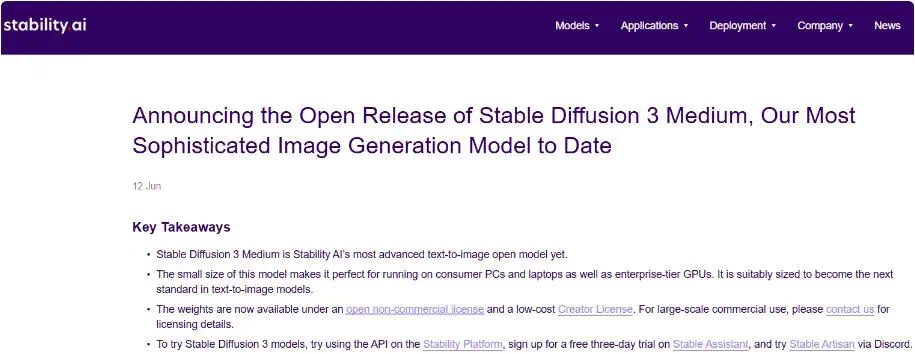When it comes to Stable Diffusion, seasoned digital enthusiasts are likely very familiar with it. This is a deep learning model developed by Stability AI, capable of generating high-quality images from textual descriptions. There are currently many applications of this type, which most people have likely experienced.
Objectively speaking, Stable Diffusion is currently at the forefront of this field. However, it has some drawbacks, such as high hardware requirements, a steep learning curve, high difficulty, and expensive licensing fees. At this stage, it is mainly favored by a small group of professionals and enthusiasts.

Recently, there’s good news about Stable Diffusion. On June 12th, Stability AI officially released Stable Diffusion 3 Medium (pictured above), claiming it is the “latest and most advanced” text-to-image AI model in the Stable Diffusion 3 series and an “important milestone in generative AI development.”
Stable Diffusion 3 Medium is a 2 billion parameter SD3 model. Stability AI is currently developing multiple versions, and this version is neither the smallest nor the largest, with a medium parameter count, hence the name “Medium” version. This model is free, open but not open-source, and requires a license for commercial use.
Stable Diffusion 3 Medium can generate images with better details, colors, and lighting effects, resulting in more realistic and higher-quality images. Innovations such as 16-channel VAE have successfully addressed common flaws in other models, such as the realism of hands and faces.
It understands complex descriptive texts faster and more accurately, including texts involving spatial reasoning, compositional elements, actions, and styles.
Font and typography have been improved, and by using the Diffusion Transformer architecture, it can deliver unprecedented text quality, reducing errors in spelling, kerning, letter formation, and spacing.
Additionally, it can extract subtle details from small datasets, making it ideal for customization.
The performance and efficiency have been optimized, reducing the demand for VRAM to some extent, so it can run on consumer-grade graphics cards, suitable for laptops and desktops with ordinary consumer-grade graphics cards. However, the higher the configuration, the better.
Currently, Stable Diffusion 3 Medium is available for download, with two versions, including versions for Nvidia and AMD graphics cards. Users need to download the corresponding version based on their brand and model.
At this point, some people might question why there isn’t a version for Intel graphics cards, as Intel has also launched the Arc series graphics cards. The response to this is: anyone asking this question is just trying to stir up trouble. If it’s not mentioned, it means it doesn’t exist (refer to the picture below). As for the reason, those who understand will understand.

Stability AI emphasized that they will continuously improve Stable Diffusion 3 Medium based on user feedback, constantly expanding new features and improving performance.
The goal is to set a new standard for AI-generated art, aiming to make Stable Diffusion 3 Medium a powerful tool for professionals and enthusiasts alike and to work with users to shape the future of generative AI.
Related:

Disclaimer: This article is created by the original author. The content of the article represents their personal opinions. Our reposting is for sharing and discussion purposes only and does not imply our endorsement or agreement. If you have any objections, please get in touch with us through the provided channels.



